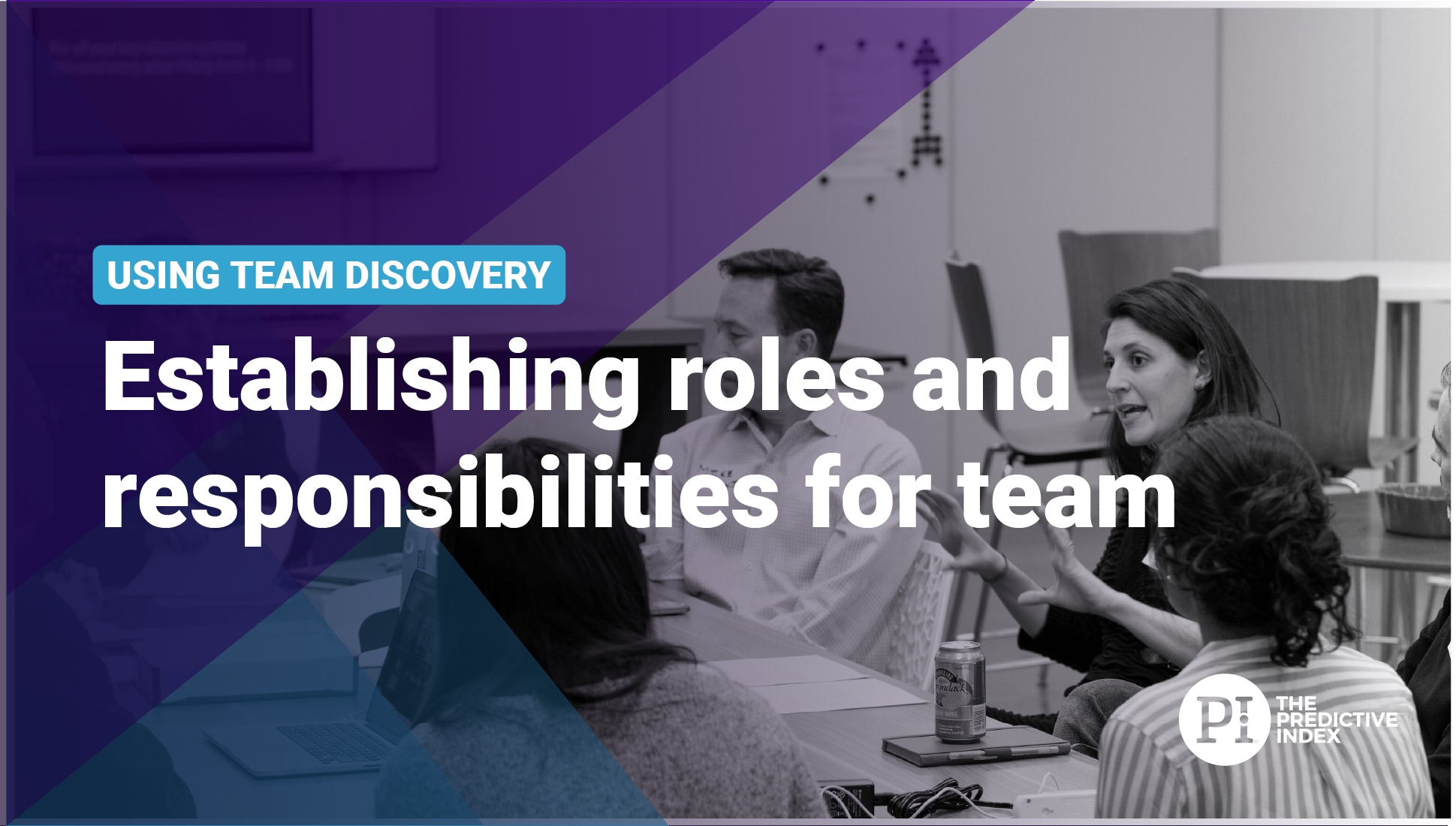There comes a point in every business when something happens that radically changes how the business operates: Leaders start to implement processes.
For employees who are used to improvising as they go and doing things their own way, this shift can be difficult. “We’ve gotten results without these processes,” they think, “Why should I change the way I’m doing things?”
Thus begins the internal struggle that comes with implementing a new process at work. The company tries to streamline tasks and increase efficiency but employees don’t want to be boxed in by a process.
A personalized leadership approach for each team member.
PI’s behavioral insights help leaders inspire and coach each employee in a way they truly connect with.
Why are processes important?
At some early stages, processes can inhibit growth. However, as your company grows, you need to create processes. It’s the only way to scale. With an increasing number of employees and clients, you need to systematize.
Not only does business process increase efficiency, but it also decreases the risk of error. Consider organizations that have spent thousands on ad campaigns—only to launch with a glaring misspelling. A process that ensured a detail-oriented editor would review the copy before it was finalized could’ve prevented that from happening.
Or what about software companies that deploy a new feature that’s buggy, causing customers to complain—or worse, leave in droves?
It’s clear creating and implementing processes is important to drive business growth, so what keeps companies from effective implementation? The same thing that typically gets in the way of change.
Why is it so hard to implement new processes at work?
We have a saying here at PI: All business problems boil down to people problems.
Process implementation is no different.
What usually gets in the way of implementing process is people. People who:
- Don’t understand why this process is necessary
- Don’t like other people telling them what to do or how to do it
- Are hesitant to change
- Are overwhelmed with the amount of change already happening in the organization
The key to successful implementation of new processes or process improvement is the same key to any successful business strategy: getting the people part right.

7 steps required to effectively implement new processes at work
Successfully introducing new processes at work requires a well-conceived strategy. Start by pinpointing what needs change, and set clear goals for the new process. What will define its success? What data will you use to measure progress?
Engaging key individuals early and listening to their feedback can make a huge difference. You’ll inevitably hear suggestions and ideas you hadn’t considered. It’s equally vital to provide thorough training to the team tasked with its implementation, and to keep everyone informed about its timeline (especially if it changes).
Set a cadence for when and how you’ll monitor progress, and adjust that monitoring as necessary. Once the process is in functioning smoothly, for example, you might not need to monitor its progress or track the data as regularly.
But remember to also celebrate progress along the way, and give credit to the people helping it come to fruition. Stay patient and consistent in your approach, and realistic about how long it may take to produce real results. In time, the new process will become a natural part of everyone’s routine.
Let’s dive a little deeper into the steps needed to maximize returns on your change investment:
1. Identify where new processes would be beneficial.
You can’t properly implement a new process without a clear grasp of why the previous approach didn’t work. Understand the current process (if one exists), and pinpoint areas for improvement. This will help in gaining support for the needed change. Lean on quantifiable or tangible outcomes – the ones that matter most to people, or that impact the business’ bottom line. And emphasize to each person what’s in it for them.
2. Define the objectives.
Clearly outline what the new process aims to achieve. Establish measurable goals and outcomes, and a plan for how they will be tracked, shared, and responded to. Frame these objectives within the context of the business’ shared goals, so that individuals from who you need buy-in see the initiative as a matter of shared fate. In other words, choose objectives that everyone can connect with, and communicate clearly how your new process will support them.
3. Engage a range of stakeholders.
Consult with everyone potentially affected by the change—this might include management, employees, and even customers. Gathering feedback early can ensure the new process is adequately communicated, and thus better received. Be efficient in your engagements though, considering and absorbing everyone’s input, without necessarily committing to acting upon them all. If you try to please everyone, you won’t move the new process forward in a timely fashion.
4. Design the new process simply and clearly.
Based on the feedback and established objectives, create a detailed blueprint of the new process. This might involve flowcharts, written procedures, or new software tools. Consider how someone who has to fill in for you might interpret the design. Is it easy to follow? Does it assume any level of existing knowledge, or omit pertinent details because you figure people are familiar with them? Try to create a design that someone could follow even after you move on – to a new role, company, or initiative. You don’t want the process to fall flat after you hand it off, negating the time and energy you put into it.
5. Communicate early and often.
Before implementation, communicate the planned changes to all involved parties. This transparency helps everyone prepared and align. Don’t set people up to fail, because you didn’t consider the ramifications of the changes to their role or responsibilities. Remember that clear is kind: You don’t need to be elaborate or super-technical in your articulation of the plan – just proactive and consistent.
6. Make training a priority.
Offer comprehensive training sessions so that everyone understands and can effectively carry out their role in the new process. Help them feel as if they’re invested and supported, involved in the new imitative from the early stages. Empower them to make suggestions and offer ideas for improvement, highlighting their progress and their grasp of the change. They’ll likely respond by championing your change and advocating for its merits throughout the business.
7. Monitor the process and gathering feedback.
Once the process is live, continue to monitor its effectiveness. Encourage feedback from users. And follow up when feedback is acted upon, or even if it’s not. This will display your commitment to bettering the process in the name of its ultimate objectives, even if it requires changing your initial outline.
Getting the people part right
Here’s how you can increase the likelihood of adoption throughout the organization:
Make process creation a strategic initiative.
If it’s not a strategic priority, process will always get the back burner in favor of immediate revenue-generating activities.
Make process creation a focus for your organization.
Rally people behind the effort by making it a key initiative related to your business goals (e.g., in order to increase predictability, you need streamlined processes). Dedicate devoted resources to the initiative, including an executive sponsor from the senior management team and a project manager. These people will help ensure the success of the initiative.
Appoint the right people to the project team.
When seeking to create and improve business processes, you need the right people on the team. At first, you might think that means solely process-minded, detail-oriented people. Those are definitely the types of behavioral attributes you’ll want for members of the project team.
This isn’t to say you shouldn’t consider a diversity of perspectives. You might still collect various perspectives as part of the change management process. However, the homogeneity of team behaviors leads to better team outcomes, so the project team should be comprised of individuals well-suited to the task.
It’s also critical you create a cross-functional team, so you can better understand how the implementation of this process will impact how other departments operate. Too often, one team creates processes that negatively impact the workflow of others. Loop in key stakeholders from each team to get an idea of how this process will impact their work.

Create a rollout plan that addresses changes to your people strategy.
When people think “implementation plans,” they often think of tactical action items required to implement a new system or process. What often goes unconsidered is how the workforce will be required to change as the result of this process. Here are a few areas to address:
Organizational culture:
How will this change impact your company culture? Will your organizational values need to change to accommodate this new process?
For example, if your company has rewarded action over process, you might have to change that core value so people adhere to the new process.
This aspect of implementing process falls on the executive team. Senior leaders should get together to discuss if the company culture needs to change and, if so, how they’ll roll out this change initiative.
Organizational structure:
In addition to determining if cultural values align with this change, senior leadership should consider if the organizational model supports the creation and implementation of new processes.
For example, a company that’s been more focused on an Exploring strategy of bringing new products to market may have a flat organizational model to enable rapid action. However, as they start to scale and grow, they might add in more layers of management to ensure processes are executed and enforced.
Tailoring communication:
Different team members have different needs when it comes to hearing about and getting on board with change.
Employees with high dominance like to exert influence on people and projects. These employees are motivated by having an opportunity to leave their mark and share their vision in the decision-making process. Even if you don’t execute quite the way they’d like for you to, they’ll still appreciate the opportunity to give their opinion.
Employees with low formality (who tend to have high dominance or extraversion) may not be as inclined to follow process or structure. Consider if there’s flexibility in approach. What control can you give them over how they execute the process? Does it have to be done exactly the way you mapped it out, or can they create their own variation? Are there things that can be done to make the process easier for them, such as through automation or delegation?
On the other hand, your high formality staff may want a clear explanation of how the process works. To support these team members, document the process and distribute. Give them time to think about the process and ask questions to clarify any misunderstandings. You might even draw parallels to existing processes to help them understand how this differs from what’s already in place, or allow them to make suggestions for improvements.
Employees with high patience like to take time to evaluate a problem and possible solutions. Exercise the value they add by asking them to “poke holes” in your process. You might try saying, “We’re thinking about implementing this process. Here’s the problem we’re trying to solve with this process and why we think this process will solve the problem. What are your concerns? How do you think we should transition?”
How PI can help
PI Team Discovery helps you build processes that last. Part of PI Design, the Team Discovery tool lets you visualize your team’s collective behavioral makeup. See where your strengths and gaps lie, and where you need to adjust based on the goals you’re pursuing. That way, you can ensure your people are in the right roles, tackling the right responsibilities.
Learn how Team Discovery helps you establish clear roles and responsibilities in this short video:

Process involves people.
If you’re not factoring people into how you roll out new processes, you’re missing a critical component to implementing new processes at work.
Join 10,000 companies solving the most complex people problems with PI.
Hire the right people, inspire their best work, design dream teams, and sustain engagement for the long haul.








